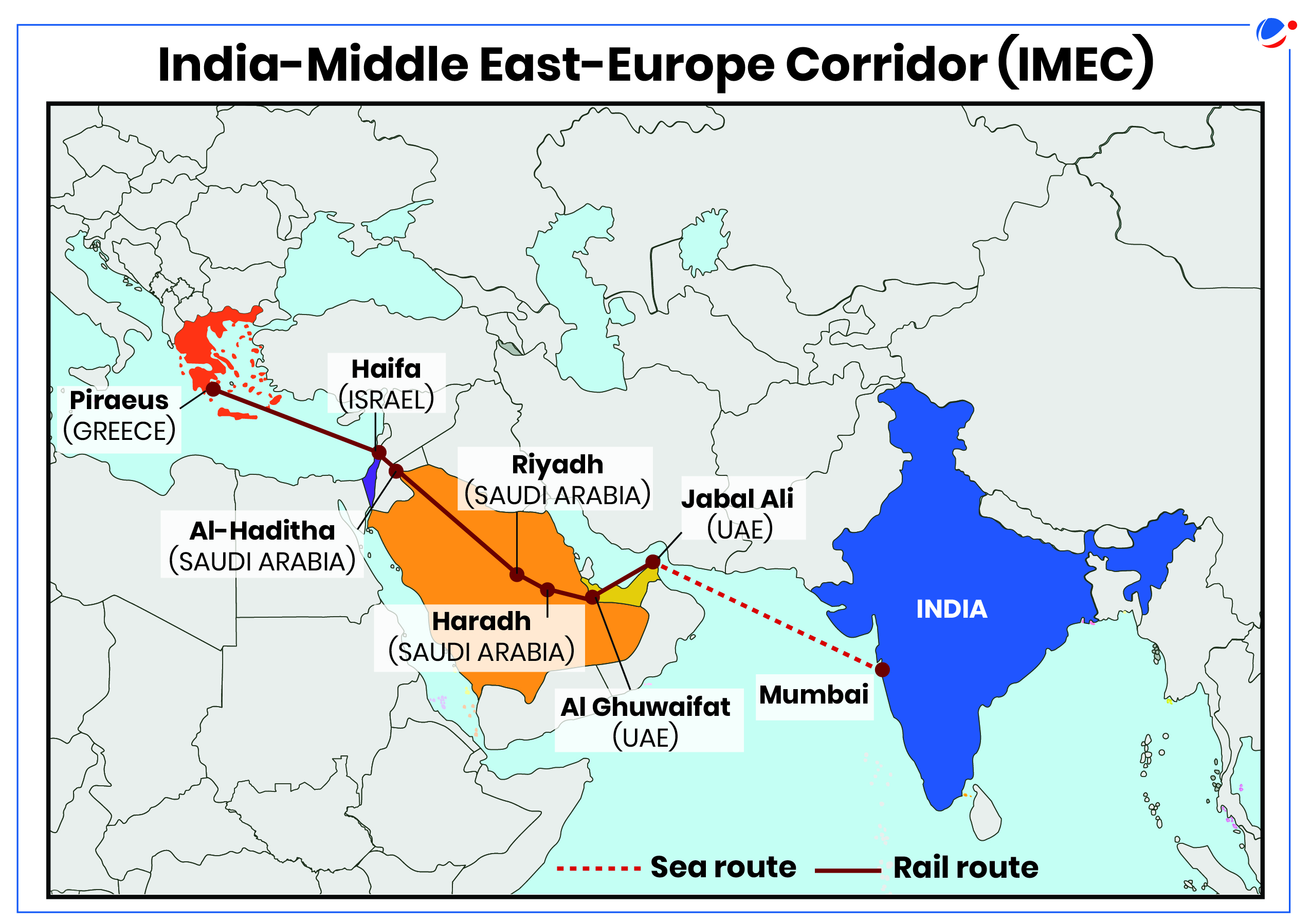Why in the News?
After one year of announcement of the ambitious transnational corridor, India-Middle East-Europe Economic Corridor (IMEC), the project has seen progress as well as some roadblocks.
About India-Middle East-Europe Economic Corridor (IMEC)

- Establishment: Through an MoU signed by leaders from India, European Union, France, Germany, Italy, Saudi Arabia, UAE and the US at the G20 Summit (2023) in New Delhi.
- Aim: Multi-modal connectivity project aimed at developing infrastructure of ports, railways, roads, sea lines and pipelines to enhance trade between India, the Arabian Peninsula, the Mediterranean region and Europe.
- It will comprise of two separate corridors:
- Eastern corridor: Connecting India to the Gulf.
- Northern corridor: Connecting the Gulf to Europe.
- The project forms part of the Partnership for Global Infrastructure and Investment (PGII).
- It was announced in 2021 during the G7 summit in the UK and is seen as a counter to China's Belt and Road Initiative (BRI).
Status of Implementation of IMEC
- Infrastructure development: Development is seen in sections like the UAE-to-Israel railway network and financing capacity expansion of Haifa port in Israel.
- Sectoral development: While Connectivity sector has gained some traction, other sectors like clean energy export, undersea fibre-optic cables and pipelines, energy grid linkages, and clean energy technology cooperation have not seen progress due to instability in West Asia.
- Development of trade processes: Steps are being taken towards standardisation and facilitation of trade processes like the 'Virtual Trade Corridor (VTC)' launched by India and the UAE.
- VTC is a part of IMEC aimed at the reduction of administrative processes and time, reduction of logistics and transportation costs, and ease of doing trade.
- Inclusive approach: The IMEC is open for expansion of regional connectivity benefits to other regional countries like Qatar, Oman, Egypt, Türkiye and Iraq.
Global significance of IMEC
- Diversifying connectivity: IMEC provides an alternative route for connectivity and trade diversification.
- Apart from physical connectivity, it also promotes digital connectivity and green energy cooperation, strengthening the spirit of plurilateralism.
- Enhancing prosperity: It would increase prosperity among the countries involved through an increased flow of energy and digital communications.
- The combined GDP of the IMEC nations (including the EU as a bloc) is roughly $47 trillion, representing about 40 percent of the world's total GDP.
- Geostrategic contributions: It aims at reducing the global economy's reliance on critical maritime chokepoints like the Suez Canal by reducing congestion and improve trade resilience.
- Geoeconomic implications: Economic integration and interdependence can create the necessary imperative towards peace in the conflict-ridden Middle East.
- Geopolitical implications: It offers an alternate approach to China's growing economic importance in the Middle East in the form of the Belt and Road Initiative (BRI).
Significance for India
- Strengthening Indo-Gulf relations: IMEC supplements the existing goal of developing Indo-Gulf trade and economic relations through improvement in infrastructure and connectivity.
- E.g. Diversification of the trade basket between India and UAE with growth of non-oil trade.
- Economic growth: IMEC will promote regional trade, attract investments in India and develop a diplomatic and political goodwill for Indian market, leading to overall economic growth.
- Faster connectivity: The shipments from India to European mainland are expected to arrive about 40% faster with 30% cost reduction than via the Suez Canal Maritime route.
- Geopolitical aspirations: By connecting the European Union (EU) and the Gulf Cooperation Council (GCC), India's 2 largest trade blocs, IMEC is a step towards achieving India's aspirations to develop faster and become a global power.
Challenges
- High costs: The complexities of multi-modal nature and lack of well-developed manufacturing capacity in the Gulf countries are potential hurdles to optimum utilization of the capacities being developed which may make freight transport costlier.
- Limited geographical coverage: Important economies of the region like Türkiye, Egypt, Iran, Qatar, etc., are not part of the IMEC.
- Existing Route: The present route passing through the Bab al- Mandab, the Red Sea and the Suez Canal is extensively used.
- The newer route is seen to be a costlier project with limited impact on the global trade.
- Regional instability: Middle-East has been facing various challenges in the form of regional conflicts like the Israel-Hamas war, the disruption of Red Sea trade by Yemen's Houthi rebels.
- The normalisation of Arab-Israel relations, the basic premise of the development of the IMEC, halted with the escalation of the conflict between Israel and Palestine.
- Financial Commitments: There is a lack of commitment regarding the financial cost.
Other Important Regional CorridorsThe International North–South Transport Corridor (INSTC)
China-led Belt and Road Initiative (BRI)
Trans-Caspian International Transport Route (TITR)
|
Conclusion
In the context of growing tensions and related uncertainty impacting global trade, new and innovative regional trade corridors can provide alternatives that complement the conventional trade routes. IMEC is one such trade corridor aimed at improving trade and connectivity in the present geopolitical situations. India has a vital role in development of these corridors. It showcases India's growing importance in trade promotion as well in the de-escalation of tensions.






